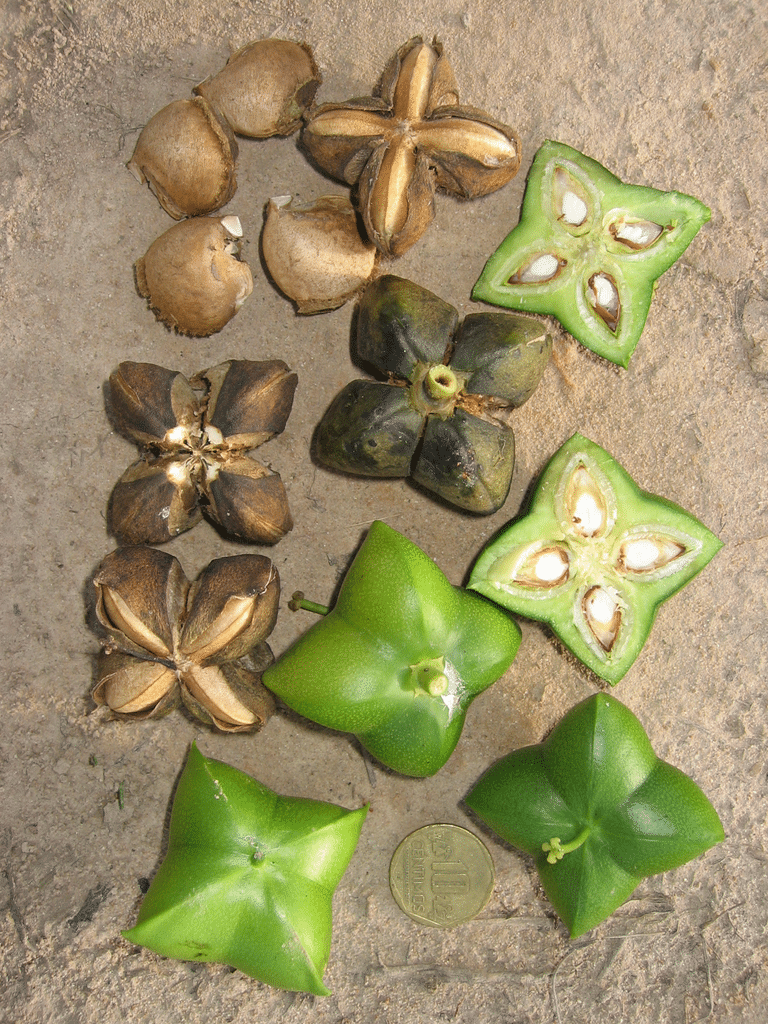Sacha Inchi:
What is it?, history, cultivation, nutritional value, uses, recipes, and more...
Sacha Inchi is an oilseed plant native to the Peruvian Amazon. Its seeds contain a high content of Omega 3 and 6 fatty acids, even greater than that found in fish, making it highly valued worldwide as a source of essential fatty acids.
Índice
What is Sacha Inchi?
Sacha Inchi is a hermaphroditic plant, a robust and fast-growing vine, semi-woody and perennial. It can reach a height of 2 meters and has alternate, toothed, and heart-shaped leaves measuring about 10 to 12 cm in length and 8 to 10 cm in width. Its flowers are small, whitish, and grow in clusters. Its fruits are capsules measuring 3 to 5 cm in diameter, green in color, usually with four to seven lobes, which turn dark brown when ripe. Each of these fruits contains an oval seed with a dark brown color, measuring 1.5 to 2 cm in diameter and weighing between 0.8 to 1.4 grams. The seeds are slightly raised in the center and indented towards the edges.
This plant was rediscovered in the 1980s due to its nutritional properties (it contains Omega 3, 6, and 9 fatty acids at around 49% to 53% and proteins at 33%). Since then, its cultivation has greatly expanded in Peru, Ecuador, Costa Rica, and Colombia.
History of Sacha Inchi
Sacha Inchi was first described as a species in 1753 by the naturalist Linnaeus, and it was then that it acquired its scientific name: Plukenetia volubilis Linnaeus. There is evidence that this plant was part of the dietary and medicinal practices of pre-Inca and Inca cultures, as phytomorphic vessels representing the fruit and the plant have been found from the pre-Inca Chimú and Mochica societies.
Subsequently, Inca Garcilaso de la Vega in “The Royal Commentaries of the Incas” refers to it as follows:
“There is another fruit that grows under the ground, which the Indians call inchic and the Spaniards call peanuts (all the names that the Spaniards give to fruits and vegetables of Peru are from the language of the Windward Islands, which they have introduced into their Spanish language, and for this reason, we give an account of them), the inchic is very similar, in the kernel and in taste, to almonds; if eaten raw, it offends the head, and if roasted, it is tasty and beneficial; with honey, they make good nougat from it; they also extract a very nice oil from inchic for many illnesses.”
In 1951, in Volume VII of Promising Plant Species of the Andrés Bello Convention, it is stated:
“…The Yahuas, Cocamas, Shipibos, and Chayahuitas consume the tender leaves of Plukenetia volubilis in the form of salads as part of their diet…[CIDRAP, 1976]”
Records of its origin in Peru can be found in the northeastern pre-Inca cultures, through representations of the fruit in Chimú and Mochica vessels; as shown by some vessels depicting this vine with its star-shaped fruits…[CIDRAP, 1985]”
Much later, in 2008, an article titled “Our True Bank of Gold” was published in El Comercio’s magazine “Somos Nº 1103,” dedicated to Santiago Antúnez de Mayolo Rynning, considered a prominent scholar of ancient Peruvian nutrition. The article discusses the properties of Sacha Inchi:
“The chronicler Joseph de Acosta reported in 1567 that in Puno, our Indians learned something in 2 months that the Spaniards required 5 months for. That’s because they had excellent nutrition: they ate fish, guinea pig fat, sacha inchi, foods that developed their brain, which unfortunately is not taken into account now.”
“Sacha inchi was already known since 1950, but its use was lost because, being a ‘native thing,’ nobody paid attention to it. Nobody knows to what extent it was cultivated in Ancient Peru, but once I found a sample similar to a small bean in Nazca. The analysis showed that it was sacha inchi.”
The internationalization of this plant began in 1980, thanks to fatty acid and protein content analyses conducted at the Institute of Food Science at Cornell University in the USA and by Duclos in Florida (C.R. Valles 1993), which demonstrated that the seeds of Plukenetia volubilis L. contain 48% oil and 29% protein (Hazan and Stoewesand, 1980). Since then, Sacha Inchi has been repeatedly recognized worldwide for its high omega content. Exports of these seeds only began in 2004, with the first shipments to France focused on the cosmetic industry.

Common Name of Sacha Inchi
| Spanish | Sacha inchic, Maní del inca, maní del monte, maní estrella, inca peanut, Sacha maní, sacha inche, Fragariopsis, N`gart (FAO), Supua ( Bolivia), Amauebe, amui-o (v. huitoto), sacha inchic, maní del monte, sacha yachi, sacha yuchi, sacha yuchiqui, yuchi( v. cashibo), sampannankii, suwaa ;sacha inchik, kechua de San Martín |
Scientific Name of Sacha Inchi
Plukenetia volubilis
Taxonomy of Sacha Inchi
| Kingdom | Plantae |
| Subkingdom | Tracheobionta |
| Division | Magnoliophyta |
| Class | Magnoliopsida |
| Subclass | Rosidae |
| Order | Malpighiales |
| Family | Euphorbiaceae |
| Subfamily | Acalyphoideae |
| Tribu | Plukenetieae |
| Subtribu | Plukenetiinae |
| Gender | Plukenetia |
| Specie | P. volubilis |
Synonyms of Sacha Inchi
Sajorium volubile (L.) Baill. (1858).
Plukenetia peruviana Müll.Arg. (1865).
Plukenetia macrostyla Ule (1908 publ. 1909).
Fragariopsis paxii Pittier (1929).
Etymology of Sacha Inchi
The name of this Amazonian fruit comes from two Quechua words: “sacha,” meaning “tree or shrub,” and “inchi,” meaning “seed or nut.” Therefore, “sacha inchi” literally translates to “seed of the tree.”
Habitat of Sacha Inchi
- Habitat
(Original and current cultivation areas based on climate, soil, etc. - see example on Wikipedia)
Sacha Inchi is a plant that was cultivated by the Incas for centuries and adapts to warm or moderate climates up to 1700 meters above sea level, as long as there is a constant water supply and good drainage. It thrives in acidic, loamy, and alluvial flat soils, near rivers.
Globally, Plukenetia volubilis ranges from the Lesser Antilles, Suriname, and the northwestern sector of the Amazon basin in Venezuela and Colombia to Ecuador, Peru, Bolivia, and Brazil.
In Peru, it is found in the departments of Amazonas, Cusco, Junín, Loreto, Pasco, San Martín, and Madre de Dios.
The natural habitat of P. volubilis consists of altered vegetation areas or margins of humid tropical forests or lowlands, up to an elevation of 900 meters. Sacha Inchi plants thrive within the temperature range characteristic of the Peruvian Amazon (minimum 10 °C and maximum 36 °C). Temperatures above this maximum lead to the drop of flowers and small fruits, especially newly formed ones. When grown with low light, the plant needs more days to complete its vegetative cycle; it may even decrease flowering and consequently, production.
This plant thrives best if rainfall is evenly distributed throughout the 12 months (850–1,000 mm); hence, irrigation is crucial during dry months. Periods of extended drought or low temperatures result in slow and difficult growth. Likewise, excessive water also harms the plant and increases disease susceptibility.
The first Sacha Inchi harvest occurs at 6 to 8 months, depending on the variety, with continuous production for 5 years of useful life, extendable up to 10 years. As a vine, it requires stakes and wire trellises, but it can also be supported by living trunks.
It has two cultivation forms: an intensive one that doesn't involve shading, and another in which companion trees are used. The intensive method can lead to higher production as there's no competition for light, but the companion approach tends to experience fewer pest and disease attacks, ultimately resulting in greater profitability with lower management costs.
In the first year, about 3,000 kg of grains can be produced per hectare. In the second year, this number can increase to approximately 4,500 kg of grain, or even more, depending on the management approach.
Geographic Distribution of Sacha Inchi

San Martín, Madre de Dios, Amazonas, Junín, Huánuco, Ayacucho, Loreto, Cuzco
Seasonal Availability of Sacha Inchi
- January, February, March, April, May, November, December
Varieties of Sacha Inchi
Sacha Inchi displays wide variability, with cultivars and ecotypes differing significantly in leaf area, leaf size and shape, seed size, production capacity per plant, and grain oil content.
The Plukenetia genus, specifically, is a genus of tropical plants in the Euphorbiaceae family, consisting of 19 species, 12 of which are found in South America and 7 in Europe. Some authors even consider the presence of these species in West Africa.
In the Amazon region of Peru, agronomists have described five varieties of sacha inchi. These include Pinto Recodo, Tambo Yaguas, Muyuy, Río Putumayo, and Cumbaza.
Nutritional Value of Sacha Inchi
Most of the benefits of sacha inchi come from its rich nutrient content. Scientific studies support that sacha inchi seeds are rich in dietary fiber and essential amino acids, and should be considered an important source of health-promoting phytochemicals.
These seeds provide the nine essential amino acids (histidine, isoleucine, leucine, lysine, methionine, phenylalanine, threonine, tryptophan, and valine), which the body transforms into proteins, necessary for muscle mass formation and metabolic functions. Sacha inchi powder or flour provides 4.5 grams of protein in just one tablespoon (15 grams), a much higher content than that of chia and quinoa. Considering the recommended daily value (DV) for adults is 50 grams, a little over 3 tablespoons of this powder can fulfill your daily protein needs.
Additionally, sacha inchi oil contains 47% DV of omega-3 fatty acids, second only to flaxseed oil, which provides 57% DV. Nevertheless, the recommended daily intake of omega-3 is 1.5 grams for adults, so a tablespoon of sacha inchi oil far exceeds that amount.
Furthermore, this grain provides essential minerals like calcium and iron, both crucial for bone health and red blood cell production.
Health Benefits of Sacha Inchi
Sacha Inchi offers numerous benefits to the body. Among them, it stands out for its essential oil content that helps counteract irritable bowel problems. Moreover, the omega-3, 6, and 9 fatty acids it contains can contribute to reducing the production of triglycerides and other fats in the liver.
Contraindications or Side Effects
Although its use is quite safe, it’s recommended not to consume more than two raw Sacha Inchi seeds, as they could cause intoxication (resulting in diarrhea or cramps).
| 10 Porciones por Kilogramo | |
| Tamaño de porción | 100g |
| Cantidad por porción Calorías |
572 |
| Cantidad por 100g | |
| Energía | 2,392 kJ |
| Grasa Total | 54.4 g |
| Sodio | 3 mg |
| Carbohidratos totales | 9.9 g |
| Carbohidratos disponibles | 2.8 g |
| Fibra Dietaria | 7.1 g |
| Proteínas | 30.2 g |
| Calcio | 267 mg |
| Fósforo | 420 mg |
| Zinc | ● |
| Hierro | ● |
| Potasio | 0 mg |
| Agua | 2.8 g |
| Cenizas | 2.7 g |
| Vitamina A | ● |
| Tiamina (B1) | ● |
| Riboflavina (B2) | ● |
| Niacina (B3) | 0.58 mg |
| Vitamina C | ● |
| Acido Fólico (B9) | ● |
| β-Caroteno | ● |
| Fuente: Tablas peruanas de composición de alimentos – Centro Nacional de Alimentación y Nutrición – Ministerio de Salud – Perú | |
Derived Products and Consumption Forms of Sacha Inchi
Uses of Sacha Inchi
While the primary use of Sacha Inchi is through pressing and transforming it into oil in the culinary industry due to its high content of Omega-3, Omega-6, a good level of proteins, and essential amino acids, it is also highly sought after for its medicinal and cosmetic benefits.
- Culinary
- Medicinal
- Industrial
- Ritual
Culinary Use of Sacha Inchi
In Peru, the Social Health Insurance (EsSalud) has recommended Sacha Inchi consumption because it helps reduce high cholesterol and triglyceride levels, protects the heart, and is an ally against metabolic syndrome. One simple way to consume it is by taking a tablespoon of the oil with lunch in salads. It is also advised to eat it as roasted seeds, about 7 to 10 units per day. It's important to note that this oil is not suitable for frying, as it alters its chemical composition.
Indigenous societies like Sharanahua, Yanesha Arahuaca, Aguaruna, Arabela, Chayahuita, Yahua, Shipibo-Conibo, Huitoto, Marui, Campa del Gran Pajonal, Machiguenga, Campaahaninca, Mayoruna, San Martín Quechua, and Tigre Quechua extract Sacha Inchi oil using traditional methods for culinary preparations and fuel. Additionally, the Yahuas, Cocama-Cocamillas, Shipibo-Conibas, and Chahuahitas consume the leaves in salads as part of their diet.
Among the main typical dishes using Sacha Inchi in urban and rural populations of the Peruvian rainforest are:
Incachapi: Sacha Inchi with corn and chicken meat, cilantro, garlic, boiled.
Lechona api: Sacha Inchi with scraped green plantain, boiled.
Pururuca: Sacha Inchi with ripe plantain, boiled.
Cutacho: Roasted Sacha Inchi, ground with salt and green plantain, ground with salt and water.
Sacha Inchi butter: Roasted Sacha Inchi ground with salt and water.
Ichi Cucho: Sacha Inchi with ground chili, boiled.
Sacha Inchi tamale: Sacha Inchi and ground corn, boiled.
Upe: Roasted Sacha Inchi and ground corn, boiled.
Sacha Inchi Chicha: Sacha Inchi and ground white corn, boiled.
Salditos: Roasted Sacha Inchi with salt.
Sacha Inchi nougat: Roasted Sacha Inchi and chancaca.
Medicinal Use of Sacha Inchi
In the Peruvian Amazon, elderly individuals from the Mayoruna, Chahuahuita, Asháninca, Shipibo-Conibo, Yahuas, and Boras communities mix Sacha Inchi oil with almond flour to prepare a special cream for revitalizing the skin. The Secoyas, Candoshis Yaneshas, Cashibos, Depanahuas, and Boras consume these toasted nuts to regain strength, as well as to rub on their bodies and to alleviate muscle and rheumatic pain.
More broadly, Sacha Inchi is known for the following medicinal benefits:
Natural antioxidant
Strengthens the immune system
Contributes to regulating blood pressure
Can slow the entry of glucose into the bloodstream when consumed with carbohydrate sources
Helps reduce cholesterol levels.
Industrial Use of Sacha Inchi
Sacha Inchi is widely used in the pharmaceutical industry as a supplement due to its high concentration of omega fatty acids that promote cardiovascular health and help reduce the risk of inflammatory diseases.
Furthermore, Sacha Inchi has gained popularity in the cosmetic industry, where its oil is used in various products, including soaps and shampoos.
Ritual Use of Sacha Inchi
It is believed that this grain had ceremonial use even before the rise of the Inca Empire, as seeds depicted in pottery have also been found in burial sites of the Chachapoyas civilization around 800 CE.



